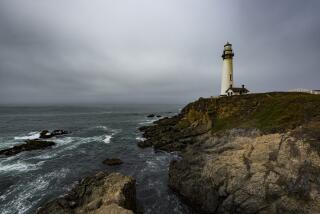Serenity, scenery go hand in hand at Utah’s Capitol Reef National Park
- Share via
There is just one paved road in Capitol Reef National Park in southern Utah. It is an eight-mile scenic drive on which the only traffic jams are caused by an occasional herd of mule deer. Instead of honking horns, Capitol Reef is about serenity and spectacular scenery. “We are remote,” says park ranger Lori Rome, “which is part of the appeal of this place.” Here’s how to get the most out of this park.
The history
Capitol Reef was granted national park status in 1971, making it one of the country’s youngest. In the late 1800s, Mormon polygamist families established the community of Fruita, which is now park headquarters. About 3,000 fruit trees remain from what once was a thriving fruit-producing area, which saw its residents slowly drift away, frustrated by floods and drought.
What’s it about?
Like other parks in Utah, Capitol Reef is about geology. It is said that the area got its name because early visitors thought some of the rock formations, especially along the Fremont River, reminded them of the dome atop the U.S. Capitol.
The land inside the park is part of a 100-mile buckling of the Earth’s crust, named the Waterpocket Fold by explorer John Wesley Powell because of indentations in the rock that catch rainwater.
Best ways to see it
Utah 24 traverses Capitol Reef and provides the only official entrance, and it’s dramatic. Chimney Rock looms on the left, while Panorama Point, Sunset Point and Goosenecks Overlook provide inspiring views of the canyon below.
As sunset approaches, photographers line the rim to capture the intense red light that paints the nearby rock walls. A short distance down the road rises the Castle, a formidable rocky fortress visible from several points and a favorite stop for visitors.
The scenic drive, which begins just off 24 near the visitors center, is about 16 miles round trip. Forget the self-guided driving-tour pamphlet available at the visitors center, which is helpful only if you are really into the geology of the rock formations. Instead, use a Trails Illustrated map and plan to stop often just to take in the scenery.
The drive ends at a picnic area near Eph Hanks Tower, which is popular with rock climbers. An unpaved road will take you into Capitol Gorge. The narrow road through the gorge once was the main route into Capitol Reef.
High points
Capitol Reef is a hiker’s park, with trails ranging from gentle to challenging. One of the most popular is the relatively easy hike to Hickman Bridge, a natural rock span that rises 125 feet above the trail. From the parking lot, the well-marked trail climbs about 400 feet to the “oh, my gosh” view of the bridge. This bridge is on par with those found farther north in Arches National Park.
If you do not take any other hike in the park, hike this trail. Not only does it include the bridge but also a view of Pectol’s Pyramid — a sandstone monolith named after an early advocate for protecting the Capitol Reef area.
Other spectacular monoliths can be found in the park’s Cathedral Valley. The route involves fording the Fremont River in your car and then traveling on mostly unmaintained roads. Head into this area if the weather is dry and you have a high-clearance vehicle. In wet weather, the river is too high to ford, and rain makes the roads slippery. Be sure to take extra water and have a full tank of gasoline as well as a spare tire. It’s a slow drive through Cathedral Valley, but the rewards are substantial.
Perhaps the best known of the many monoliths in Cathedral Valley are the 400-foot-tall Temple of the Sun and the Temple of the Moon. Sunrise on these monoliths can be amazing and almost otherworldly. We rose at 4 a.m. to arrive in time for sunrise, and it definitely was worth the effort. From there, you have several choices and can easily spend a full day observing the different monoliths.
Taking a break
Near the start of the scenic drive is the entrance to the Fruita Campground, where my partner, Gloria Cortes, and I stayed last summer. It is the park’s fully equipped campground, with only 71 sites on a first-come basis. People usually begin to line up about 9 a.m. to grab a campsite as soon as one becomes available.
If camping is not your thing, the nearby town of Torrey has half-a-dozen hotels and motels and some good places to eat. It also has the nearest gas stations, as no fuel is available in the park.
More to Read
Sign up for The Wild
We’ll help you find the best places to hike, bike and run, as well as the perfect silent spots for meditation and yoga.
You may occasionally receive promotional content from the Los Angeles Times.






